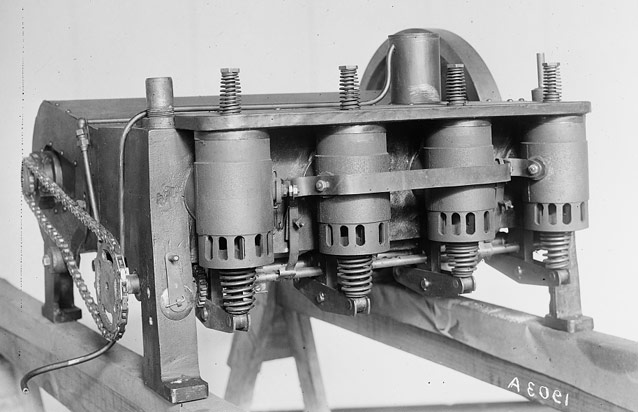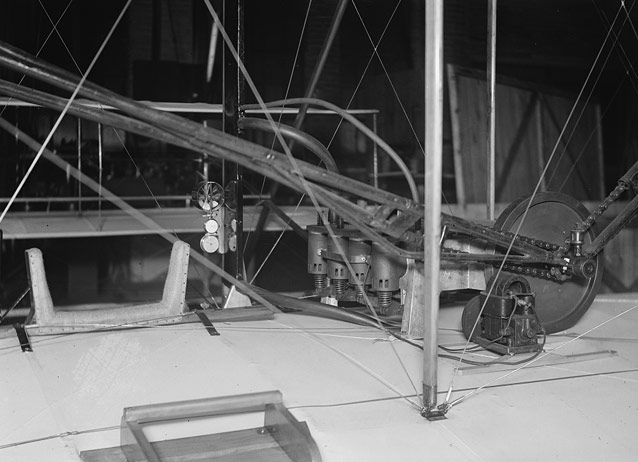
Wilbur and Orville Wright
The Wright Flyer (sometimes called the Flyer 1 or the 1903 Flyer) was the first heavier-than-air, powered aircraft to fly successfully. On December 17th, 1903 at 10:35 AM, after years of experimentation, the aircraft flew at Kitty Hawk, North Carolina, ushering in the aviation age.
The Wright Flyer was in many ways a natural extension of the gliders that the Wright brothers had built and tested since 1900. However, to account for the extra weight that an engine and propellers would bring to the aircraft, they had to extend the wing area to more than 500 square feet. Extending the wing area of course meant adding even more weight, and by the time of its maiden flight, the Flyer’s empty weight reached 605 lbs.

Wilbur and Orville Wright
As for the engine, the brothers reached out to many different automobile manufacturers in the hope of finding a lightweight gasoline-powered engine that could efficiently power the aircraft. Since nothing available suited their needs, the Wrights turned to their friend and coworker Charlie Taylor, who was able to build an engine from scratch.
Though the engine design was crude, even by the standards of the day, it had some remarkable features. An inline, four cylinder water-cooled engine, its crankcase was made of aluminum to reduce weight, the first time an aircraft engine had an aluminum component. Today, the majority of aircraft engines are made of aluminum. In operation, the engine could push 12 horsepower.
The engine was mounted to the right of the pilot’s cradle, necessitating the extension of the right wing by four inches, bringing the total wingspan of the Flyer to 40 feet, 4 inches. A biplane canard wing design (pitch was controlled by two small stabilizers at the front of the aircraft instead of the more common tail configuration seen on modern airplanes; the rudder was at the rear), the aircraft’s total length was 21 feet, 1 inch. Its total height reached 9 feet, 4 inches.

Wilbur and Orville Wright
The Wrights realized through experimentation and calculation that a propeller acted as a rotary wing, that it could provide both lift and thrust. They constructed two wooden propellers for the aircraft, each one measuring 8 feet, 6 inches and placed ten feet apart. They were slow turning and rotated away from each other (the left rotated counterclockwise, the right clockwise) so as to reduce negative gyroscopic effects on the aircraft in flight. The propellers were powered by a simple yet effective sprocket and chain transmission, not dissimilar to the operation of a bicycle.
The frame of the Flyer itself was made of both spruce and ash, two types of wood that are lightweight yet durable. The brothers covered the frame of the aircraft in unbleached, untreated muslin to provide a strong yet aerodynamic covering.

Wilbur and Orville Wright
If you were to enter the “cockpit” of the Wright Flyer as the brothers did at Kitty Hawk in the fall of 1903, you would lie prone in a hip cradle designed to warp the wings and control the rudder. A wooden lever in your left hand would control the elevator and you would have a rudimentary instrument panel at your disposal, consisting of a stopwatch and anemometer. A revolution counter was mounted at the base of the engine. All instruments could be turned off along with the engine by a single wooden lever located on the lower wing.

Wilbur and Orville Wright
On December 17th, 1903, at precisely 10:35 am, Orville Wright lifted off from the launching rail at Kitty Hawk (to account for taking off and landing in deep sand, the aircraft had no landing gear, rather the launching rail system consisted of four 15 foot 2x4s with a total length of 60 feet ) and flew for 12 seconds at an altitude of 8 feet, landing 120 feet away. Though their airspeed was only 31 mph and their flight was shorter than the length of a modern passenger airliner, the Wright brothers had achieved the impossible. Three more flights were made that day, each one longer than the previous.
Specifications
Length- 21 ft, 1in
Wingspan- 40 ft, 4 in
Height- 9 ft, 4 in
Empty weight- 605 lbs
Engine- inline 4 cylinder, water-cooled, 170 lbs., 12 hp
Propellers- two, 8 ft, 6 in
Maximum speed- 30 mph (est.)
Service ceiling- 30 ft (est.)
Last updated: August 16, 2017
